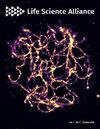将循环中的易变血红素作为抗击疟疾的目标。
IF 3.3
2区 生物学
Q1 BIOLOGY
引用次数: 0
摘要
当疟原虫(P. spp.)寄生虫侵入并溶解红细胞(RBC),产生细胞外血红蛋白(HB)并释放出游离血红素时,疟疾的严重症状就会出现。在这里,我们测试了血红蛋白(HP)和/或血卟啉(HPX)是否能清除细胞外的血红蛋白和/或游离血红素,从而抑制疟疾严重病症的发病机制。我们发现,循环中的游离血红素是儿童患重症恶性疟原虫疟疾脑型和非脑型表现的独立风险因素。游离血红素与循环中的HP和HPX呈负相关,但它们并不是重症恶性疟原虫疟疾的风险因素。遗传性 Hp 和/或 Hpx 基因缺失导致小鼠在感染疟原虫后血浆和肾脏中的游离血红素积累,这与感染疟原虫的老龄小鼠(而非成年小鼠)死亡率和急性肾损伤(AKI)发生率较高有关,血红素和 HPX 与恶性疟原虫疟疾急性肾损伤血清学标志物之间的反相关性也证实了这一点。总之,HP 和 HPX 以年龄依赖的方式防止小鼠(可能也包括人类)出现严重疟疾的发病机制。本文章由计算机程序翻译,如有差异,请以英文原文为准。
Targeting circulating labile heme as a defense strategy against malaria.
Severe presentations of malaria emerge as Plasmodium (P.) spp. parasites invade and lyse red blood cells (RBC), producing extracellular hemoglobin (HB), from which labile heme is released. Here, we tested whether scavenging of extracellular HB and/or labile heme, by haptoglobin (HP) and/or hemopexin (HPX), respectively, counter the pathogenesis of severe presentations of malaria. We found that circulating labile heme is an independent risk factor for cerebral and non-cerebral presentations of severe P. falciparum malaria in children. Labile heme was negatively correlated with circulating HP and HPX, which were, however, not risk factors for severe P. falciparum malaria. Genetic Hp and/or Hpx deletion in mice led to labile heme accumulation in plasma and kidneys, upon Plasmodium infection This was associated with higher incidence of mortality and acute kidney injury (AKI) in ageing but not adult Plasmodium-infected mice, and was corroborated by an inverse correlation between heme and HPX with serological markers of AKI in P. falciparum malaria. In conclusion, HP and HPX act in an age-dependent manner to prevent the pathogenesis of severe presentation of malaria in mice and presumably in humans.
求助全文
通过发布文献求助,成功后即可免费获取论文全文。
去求助
来源期刊

Life Science Alliance
Agricultural and Biological Sciences-Plant Science
CiteScore
5.80
自引率
2.30%
发文量
241
审稿时长
10 weeks
期刊介绍:
Life Science Alliance is a global, open-access, editorially independent, and peer-reviewed journal launched by an alliance of EMBO Press, Rockefeller University Press, and Cold Spring Harbor Laboratory Press. Life Science Alliance is committed to rapid, fair, and transparent publication of valuable research from across all areas in the life sciences.
 求助内容:
求助内容: 应助结果提醒方式:
应助结果提醒方式:


